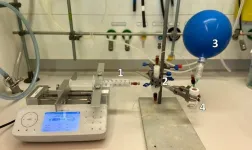(Press-News.org) In a study published in Science, researchers at Karolinska Institutet describe the neural processes behind how morphine relieves pain. This is valuable knowledge because the drug has such serious side effects.
Morphine is a powerful painkiller that belongs to the group of opioids. It blocks signals in the pain pathways and also increases feelings of pleasure.
Morphine acts on several central and peripheral pain pathways in the body, but the neural processes behind the pain relief have not previously been fully understood.
Researchers have now investigated how morphine relieves pain using several new experimental approaches. They have exposed laboratory animals to morphine and then managed to “capture” the neurons that the morphine activated in the animals. This allowed the researchers to identify, classify and synthetically control the neurons in the neural pathways involved in pain relief.
Morphine activates a 'morphine ensemble'
The researchers discovered that morphine affects a selected set of neurons in the brain in the part called the rostral ventromedial medulla (RVM). Together, these neurons form a kind of 'morphine ensemble'. This is a group of neurons whose change in activity leads to pain relief.
When the researchers synthetically inactivated the neurons in this group, they completely abolished the effects of morphine on pain. When they reactivated the neurons, they were able to similarly recreate the pain relief.
A particular type of neuron that wires to the spinal cord was found to play a central role in the 'morphine ensemble'. In the spinal cord, these neurons connect to so-called inhibitory neurons that slow down pain signaling in the spinal cord and thus prevent pain.
Potentially risky drug
When used as a medicine in healthcare, morphine has potentially very serious side effects in terms of addiction, abuse, overdose and death.
“It has been difficult to find strategies to treat pain without triggering these dangerous side effects,” says Patrik Ernfors, professor at the Department of Medical Biochemistry and Biophysics at Karolinska Institutet and the leader of the study.
He and his colleagues now hope that deeper knowledge of how morphine works in the body can help reduce side effects in the future.
“The study is important because knowledge of the neural pathway and cells may explain how morphine can have such a powerful pain-relieving effect. It may also provide information on how these processes differ from those that induce the feeling of euphoria, well-being and addiction,” says Patrik Ernfors.
In the next step, the researchers want to go further and investigate the reasons why the pain relief decreases more and more with long-term use of morphine.
The study has been funded by the Swedish Research Council, the European Research Council and the Knut and Alice Wallenberg Foundation.
Publication: Morphine-responsive neurons that regulate mechanical antinociception. Michael P. Fatt, Ming-Dong Zhang, Jussi Kupari, Müge Altınkök, Yunting Yang,
Yizhou Hu, Per Svenningsson, Patrik Ernfors, Science, online August 29, 2024, doi: 10.1126/science.ado6593
END
Mechanisms of how morphine relieves pain mapped out
2024-08-29
ELSE PRESS RELEASES FROM THIS DATE:
PFAS-free synthesis of fluorinated pharmaceutical and agrochemical compounds
2024-08-29
Chemists at the University of Amsterdam have developed a method to furnish a range of molecules with a trifluoromethyl group attached to a sulphur, nitrogen or oxygen atom. Their procedure, which has just been published in Science, avoids the use of PFAS reagents. It thus provides an environmentally friendly synthesis route for pharmaceutical and agrochemical compounds that rely on the presence of the trifluoromethyl group.
The straightforward and effective method was developed at the Flow Chemistry group at the Van ‘t Hoff Institute for Molecular Sciences ...
School of Dentistry researchers develop innovative sleep apnea model to find answers to chronic pain
2024-08-29
Scientists at The University of Texas Health Science Center at San Antonio (UT Health San Antonio) School of Dentistry created a first of its kind sleep apnea model for studying chronic pain. A study published July 30 in Science Signaling, explains the mechanism behind persistent pain related to obstructive sleep apnea.
More than 100 million people worldwide are affected by obstructive sleep apnea. This health condition causes a person to stop breathing numerous times while they are sleeping. Reduced sleep time and sleep quality can lead to numerous health problems including chronic pain, which is diagnosed at a much higher rate ...
Plastic surgery patients who use marijuana also have elevated nicotine levels
2024-08-29
August 29, 2024 — Marijuana use is common among patients considering plastic surgery and is associated with elevated nicotine levels on laboratory tests, reports a paper in the September issue of Plastic and Reconstructive Surgery®, the official medical journal of the American Society of Plastic Surgeons (ASPS). The journal is published in the Lippincott portfolio by Wolters Kluwer.
"We found that patients who report marijuana use also have elevated urine nicotine and cotinine levels ...
Machine learning predicts which patients will continue taking opioids after hand surgery
2024-08-29
August 29, 2024 — A machine learning algorithm performs well in predicting the risk of persistent opioid use after hand surgery, reports a study in the August issue of Plastic and Reconstructive Surgery®, the official medical journal of the American Society of Plastic Surgeons (ASPS). The journal is published in the Lippincott portfolio by Wolters Kluwer.
"We found that a machine learning model performs well in identifying hand surgery patients who are more likely to become persistent opioid users," comments ASPS ...
$15.5 million NIH award funds development of national network to include nursing home residents in clinical trials
2024-08-29
INDIANAPOLIS – A team led by research scientists from the Indiana University School of Medicine and Regenstrief Institute has received funding expected to total $15.5 million from the National Institutes of Health’s National Institute on Aging to establish a national network structure to include more nursing home residents in clinical trials.
Even though clinical trials are critical to the development and testing of medical therapies and treatments including drugs and care models, individuals living in nursing homes are rarely included in clinical research studies.
The new five-year award will fund ...
What’s in the microbiome of the foods we eat?
2024-08-29
Microbes are part of the food we eat and can influence our own microbiome, but we know very little about the microbes in our foods. Now, researchers have developed a database of the “food microbiome” by sequencing the metagenomes of 2,533 different foods. They identified 10,899 food-associated microbes, half of which were previously unknown species, and showed that food-associated microbes account for around 3% of the adult and 56% of the infant gut microbiome on average. The study published August 29 in the journal ...
Scientists discover how starfish get ‘legless’
2024-08-29
Researchers at Queen Mary University of London have made a groundbreaking discovery about how starfish manage to survive predatory attacks by shedding their own limbs. The team has identified a neurohormone responsible for triggering this remarkable feat of self-preservation.
Autotomy, the ability of an animal to detach a body part to evade predators, is a well-known survival strategy in the animal kingdom. While lizards shedding their tails are a familiar example, the mechanisms behind this process remain largely mysterious.
Now, scientists have unveiled a key piece of the puzzle. By studying the common European starfish, ...
Hormone therapy and biological aging in postmenopausal women
2024-08-29
About The Study: Postmenopausal women with historical hormone therapy (HT) use were biologically younger than those not receiving HT, with a more evident association observed in those with low socioeconomic status. The biological aging discrepancy mediated the association between HT and decreased mortality. Promoting HT in postmenopausal women could be important for healthy aging.
Corresponding Author: To contact the corresponding author, Chenglong Li, PhD, email chenglongli@bjmu.edu.cn.
To access the embargoed study: Visit our For The Media website at this link https://media.jamanetwork.com/
(doi:10.1001/jamanetworkopen.2024.30839)
Editor’s ...
Persistent neighborhood poverty and breast cancer outcomes
2024-08-29
About The Study: The findings of this study of women ages 18 or older diagnosed with stage I to III breast cancer between 2010 and 2018 suggest that residing in persistently impoverished neighborhoods is associated with poor tumor characteristics and increased mortality.
Corresponding Author: To contact the corresponding author, Samilia Obeng-Gyasi, MD, MPH, email samilia.obeng-gyasi@osumc.edu.
To access the embargoed study: Visit our For The Media website at this link https://media.jamanetwork.com/
(doi:10.1001/jamanetworkopen.2024.27755)
Editor’s Note: Please see the article for additional information, including other authors, ...
Greenhouse gas emissions and costs of inhaler devices in the US
2024-08-29
About The Study: Inhaler prescriptions filled by Centers for Medicare & Medicaid Services beneficiaries in 2022 resulted in an estimated 1.15 million metric tons of carbon dioxide equivalent emissions, equivalent to 226,960 homes’ yearly electricity use. Metered-dose inhalers were responsible for nearly all inhaler-related emissions, with the largest contribution arising from short-acting β-agonist medications. Although dry-powder and soft-mist inhalers had substantially lower emissions, they accounted for a disproportionate amount of spending, representing nearly two-thirds ...





